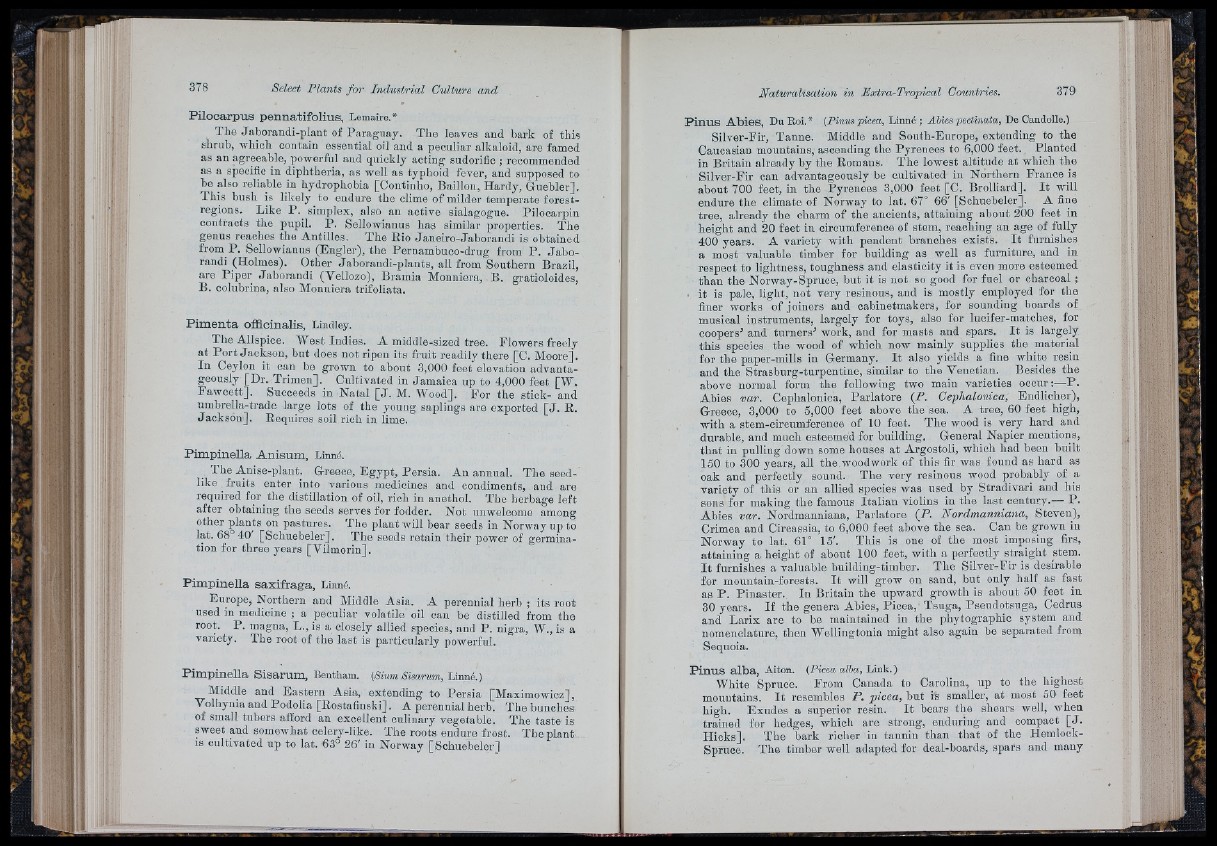
í -■
i¡;
■:j:i, i:í ■
4 ■
.:■( -
Pilocarpus pennatifolius, Lemaire.*
The Jaborandi-plant of Paraguay. The leaves and bark of this
shrub, which contain essential oil and a peculiar alkaloid, are famed
as an agreeable, powerful and quickly acting sudorific ; recommended
as a specific in diphtheria, as well as typhoid fever, and supposed to
he also reliable in hydrophobia [Continho, Bâillon, Hardy, Guebler].
This bush is likely to endure the clime of milder temperate forest-
regions. Like P. simplex, also an active sialagogue. Pilocarpin
contracts the pupil. P . Sellowianus has similar properties. The
genus reaches the Antilles. The Rio Janeiro-Jaborandi is obtained
from P . Sellowianus (Engler), the Pernambuco-drug from P . Jabo-
randi (Holmes). Other Jaborandi-plauts, all from Southern Brazil,
are Piper Jaboraudi (Vellozo), Bramia Monniera, B. gratioloides,
B. colubrina, also Monniera trifoliata.
Pimenta offlcinalis, Lindley.
The Allspice. West Indies. A middle-sized tree. Elowers freely
a t P o rt Jackson, but does not ripen its fruit readily there [C. Moore].
In Ceylon it can be grown to abont 3,000 feet elevation advantageously
[Dr. Trimen]. Cultivated in Jamaica up to 4,000 feet [W.
F aw c e tt]. Succeeds iu Natal [ J . M. Wood]. For the stick- and
umbrella-trade iarge lots of the young saplings are exported [ J . R.
Ja ck so n ]. Requires soil rich in lime.
Pimpinella Anisum, Linné.
The Anise-plant. Greece, Egypt, Persia. An annual. The seedlike
^ fruits enter into various medicines and condiments, and are
required for the distillation of oil, rich in anethol. The herbage left
after obtaining the seeds serves for fodder. Not unwelcome among
other plants on pastures. The plant will bear seeds in Norway np to
lat. 68° 40' [Schuebeler]. The seeds retain their power of germination
for three years [Vilmorin].
Pimpinella saxifraga, Linné.
Europe^ Northern and Middle Asia. A perennial herb ; its root
used in medicine ; a peculiar volatile oil can be distilled from the
root. P. magna, L., is a closely allied species, aud P. nigra, W., is a
variety. The root of the last is particularly powerful.
Pimpinella Sisarnm, Bentham. [Slum Sisarum, Linné.)
Middle and Eastern Asia, extending to Persia [Maximowicz],
Volhyuia and Podolia [Eostaflnski]. A perennial herb. 'The bunches
of small tubers afford an excellent culinary vegetable. The taste is
sweet and somewhat celery-like. 'The roots endure frost. 'The plant
is cultivated up to lat. 63° 26' in Norway [Schuebeler]
379
P i n u s A b ie s , Du Roi.* {Phmspicea, Linné ; Ahies pectinata, De Candolle.)
Silver-Fir, Tanne. Middle and South-Europe, extending to the
Caucasian mountains, ascending the Pyrenees to 6,000 feet. Planted
in Britain already by the Eomans. 'The lowest altitude at which the
Silver-Fir can advantageously be cultivated in Northern France is
about 700 feet, in the Pyrenees 3,000 feet [C. Brolliard]. I t will
endure the climate of Norway to lat. 67° 66' [Schuebeler]. A fine
tree, already the charm of the ancients, attaining about 200 feet in
height and 20 feet in circumference of stem, reaching an age of fully
400 years. A variety with pendent branches exists. I t furnishes
a most valuable timber for building as well as furniture, and in
respect to lightness, toughness and elasticity it is even more esteemed
than the Norway-Spruce, but it is not so good for fuel or charcoal ;
■ it is pale, light, not very resinous, and is mostly employed for the
finer works of joiners and cabinetmakers, for sounding boards of
musical instruments, largely for toys, also for lucifer-matches, for
coopers’ and turners’ work, and for masts and spars. I t is largely
this species tlie wood of which now mainly supplies the material
for the paper-mills in Germany. I t also yields a fine white resin
and the Strasbnrg-turpentine, similar to the Venetian. Besides the
above normal form the following two main varieties occur:—P .
Abies var. Cephalonica, Parlatore (P. Gephalonica, Endlicher),
Greece, 3,000 to 5,000 feet above the sea. A tree, 60 feet high,
with a stem-circumference of 10 feet. The wood is very hard Bind
durable, and much esteemed for building. General Napier mentions,
th a t in pulling down some houses a t Argostoli, which had been built
150 fo 300 years, all the woodwork of this fir was found as hard as
oak and perfectly sound. The very resinous wood probably of a
variety of this or an allied species was used by Stradivari and his
sons for making the famous Italian violins in the last century.— P.
Abies var. Nordmanniana, Parlatore (P. Nordmanniana, Steven),
Crimea and Circassia, to 6,000 feet above the sea. Can be grown in
Norway to lat. 61° 15'. This is one of the most imposing firs,
attaining a height of about 100 feet, with a perfectly straight stem.
I t furnishes a valuable building-timber. The Silver-Fir is desirable
for mountain-forests. I t will grow on sand, but only half as fast
as P . Pinaster. In Britain the upward growth is about 60 feet in
30 years. I f the genera Abies, Picea, Tsuga, Psendotsuga, Cedras
and Larix are to be maintained in the phytographic system and
nomenclature, then Wellingtonia might also again he separated from
Sequoia.
P i n u s a lb a , Aiton. {Picea alba. Link.)
White Spruce. From Canada to Carolina, up to the highest
mountains. I t resembles P. picea, hut is smaller, at most 50 feet
high. Exudes a superior resin. I t bears the shears well, when
trained for hedges, which are strong, enduring and compact [ J .
Hicks]. 'The bark riclier in tannin than th a t of the Hemlock-
Spruce. The timber well adapted for deal-hoards, spars and many